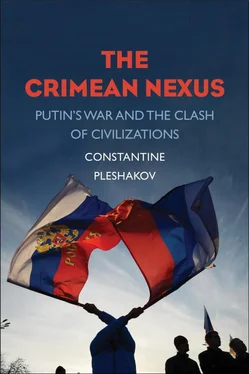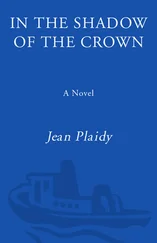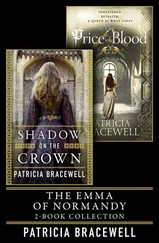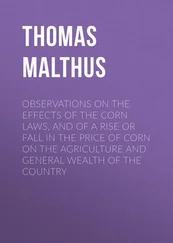The very notion of the “territory of Ukraine” remained unresolved. The Paris Peace Conference of 1919 refused to recognize it as a state. Woodrow Wilson was a strong proponent of a revived Poland but entertained no such ideas about Ukraine. The revived Poland, meanwhile, occupied Galicia in the spring of 1919 and received the allied powers’ blessing. [14] MacMillan, Paris 1919 , 71; Subtelny, Ukraine , 371.
It is ironic that bringing down statues of Lenin became a mark of the civil conflict in Ukraine in 2013–2016, because Lenin is the person who put Ukraine on the political map. Under Soviet rule, the Ukrainian Soviet Socialist Republic was endowed with all the attributes of a state.
When the Union of Soviet Socialist Republics was in the works in the fall of 1922, Lenin was a dying man. A succession of strokes, striking at an early age (he turned fifty-two that year), bestowed bitter lucidity upon him. The state he was leaving behind was terribly unfair, and the person likely to succeed him, Joseph Stalin, was certain to make it even more repressive. The principles of the Union became Lenin’s last battle. Stalin wanted minorities in the USSR to have cultural autonomy—meaning just titular recognition of ethnic diversity. Lenin wanted the larger ethnicities to have quasi-states with all the attributes of sovereignty, including maintaining their own borders with the outside world—the latter was a provision Lenin insisted on, in case a republic chose to secede. [15] Robert Service, Lenin: A Biography (Cambridge, Mass.: The Belknap Press, 2000), 455, 468–469; Suny, The Soviet Experiment , 308.
Within a few years, Ukraine had established itself as second among equals in the USSR, after Russia proper. In 1945, at Stalin’s insistence, the United States accepted the Ukrainian Soviet Socialist Republic as a founding member of the United Nations—a bizarre arrangement legitimizing Ukraine’s ersatz sovereignty (the only other faux state among the U.N. founding members was another Slavic Soviet republic, Belorussia).
Having Polonized with the Poles and Russified with the Russians, in the Soviet Union the Ukrainian elites Sovietized. Together with Russians, Ukrainians made up the bulk of the Communist Party, KGB, police, and officer corps. The leader of the USSR between 1964 and 1982, Leonid Brezhnev, came from Ukraine, as did several other Politburo members. [16] Subtelny, Ukraine , 499.
No other republic of the union increased its territory as much as Ukraine did. In 1939, after dividing up Poland with Hitler, Stalin assigned Galicia to the Ukrainian SSR. Ukraine now encompassed both former Russian and former Polish territories. In 1954, Nikita Khrushchev awarded it Crimea. As Orest Subtelny noted, because Crimea was the “historic homeland of the Crimean Tatars,” the Russians did not have “the moral right to give it away nor did the Ukrainians have the right to accept it.” [17] Bilenky, Romantic Nationalism in Eastern Europe , 303; Suny, The Soviet Experiment , 435; Subtelny, Ukraine , 500.
Lenin’s 1922 provisions paved the way for the bloodless disintegration of the USSR in 1991: the republics had a right to secede, and the fact that each had a border with the outside world facilitated this. Ukraine seceded from the union with most structures of statehood already in place—ministries, law enforcement, schools, research centers, power grid, transportation system, even a modest foreign service. The military had to be reorganized, but not forged anew: Ukraine had inherited the Soviet Union’s well-trained officer corps, infrastructure, and arsenals.
But tensions among different regions, frozen by the federal Soviet state for decades, now surfaced. As in Russia, the post-Soviet transition to a free market economy led to the emergence of an exploitative class of the shady new rich, presided over by the oligarchs—fifty people owning about 85 percent of national wealth. Their business empires tended to be region-based, contributing to general fragmentation. Times were especially hard in eastern and southern Ukraine: that’s where the Soviet-era megalomaniac industry enterprises, now unfit for the new economy, were. Already in the early 1990s, thoughtful observers, of which Ambassador Jack F. Matlock was one, “began to wonder if Ukraine could retain its unity if the process of regional estrangement continued.” [18] Jack F. Matlock, Autopsy of an Empire: The American Ambassador’s Account of the Collapse of the Soviet Union (New York: Random House, 1995), 700.
Ukrainian politics became incredibly volatile. In the 2012 parliamentary elections, the party of the hero of the Orange Revolution in 2004, Viktor Yushchenko, received barely more than 1 percent of the vote. Riches to rags has been the fate of many a politician, but the Ukrainian seesaw suggests an electorate entirely divorced from the political machine, feeling no loyalty to and, for sure, no trust for any political force. Political parties are the dayflies of Ukrainian politics, set up by a leader on the eve of general vote, only to crumble after serving the campaign’s purposes. Almost twenty-five years since independence, Ukraine’s multiparty system remains tentative and unstable. This instability is a direct outgrowth of the country’s historical lack of definition.
In The Clash of Civilizations , Samuel P. Huntington defined Ukraine as “cleft” and Russia as “torn.” “Torn” countries, Huntington argued, were the ones struggling with their civilizational belonging; “cleft” nations had large groups clearly belonging to “different civilizations.” Ukraine, in Huntington’s view, was a “cleft country with two distinct cultures,” the “civilizational fault line between the West and Orthodoxy” running through Ukraine’s “heart.”
Huntington’s analysis seems to govern American experts’ current interpretation of the crisis. But the assumption that Ukraine is divided only along east-west lines is a damaging approximation. In Ukraine, divisions cross neighborhoods and families, not only regions. In Huntington’s terminology, Ukraine is at least as “torn” as Russia is. [19] Huntington, The Clash of Civilizations , 137, 139, 165.
The Black Sea Fleet and Sevastopol
The Soviet Union was dismantled with frightening ease and staggering thoughtlessness. Among other things, no provisions were made for the reapportioning of federal property, including the Black Sea Fleet and its facilities. [20] Colton, Yeltsin , 206.
The USSR ran twenty-six naval bases on the Black Sea. On twenty-two of them, Russian sailors went to sleep on December 24, 1991, in the Soviet Union and woke up the next morning in a foreign country. Nineteen bases were in Ukraine, three in the Republic of Georgia. The facilities in Georgia, such as Poti and Batumi, were second-tier. Ukraine had gotten the best. [21] Duygu Bazoglu Sezer, “Balance of Power in the Black Sea in the Post-Cold War Era: Russia, Turkey, and Ukraine,” in Crimea: Dynamics, Challenges, and Prospects , ed. Maria Drohobycky (London: Rowman & Littlefield, 1995), 167.
The only Black Sea port left in Russian hands was Novorossiisk (close to Sochi). Due to “adverse weather conditions,” mainly local storms from the northeast called bora (from Boreas, the Greek god of the north wind), Novorossiisk remains closed on average for two months a year. Hitting the area in fall and winter, the bora brings winds exceeding one hundred miles per hour, turning the harbor into a boiling cauldron and tossing smaller vessels ashore like toys. After a bora sank a Russian fleet in 1848, the Admiralty prohibited the navy from anchoring in Novorossiisk between November and March. The British navy’s manual warned that Novorossiisk was “very dangerous, on account of N.E. winds, which are prevalent from the month of September to the beginning of April; it sometimes blows with the fury of a hurricane,” rushing down from the mountains “with such violence, and causing such a sea, that vessels are driven on shore.” [22] Sezer, “Balance of Power in the Black Sea,” 179; The Black Sea Pilot (London: Hydrographic Office, Admiralty, 1884), 101. An American pilot repeats the warning almost verbatim: The Black Sea Pilot (Washington: Hydrographic Office, U.S. Navy, 1920), 279.
Читать дальше












